An Illustrated Guide to Child Guitar Sizes
July 19, 2020 by Taras (Terry) Babyuk
Introduction
If your child is about to start guitar lessons, you might wonder what the right guitar size for them is, given all the available options. This guide is designed to help you answer this question, with lots of other useful information to help you make the right buying decision. Read on!

What to look for when choosing a guitar
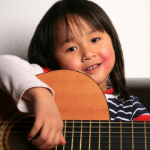
The right guitar must not be too big or too small for a child, must be comfortable to hold, and must allow the child to easily reach the top frets. If a child struggles to reach around the body of the guitar with one arm and/or can barely reach the frets with the other - you need a different guitar.
Ideally, you would be able to go to a physical store with your child and try out several different guitars before deciding on one. But if you are too busy to go guitar shopping, live too far away from a music store, or simply prefer to shop online - no problem! You can pretty reliably choose the correct guitar size for your child based on their age and a few other considerations that we talk about in this article.
Your Options
The four most popular options for child size guitars (from smallest to biggest) are the ukulele, guitalele, 1/2 size, and 3/4 size guitars. At around age 12, most children are grown enough to start using the full size guitar. Some manufacturers also offer a 1/4, 1/8 and 7/8 size guitars, but these are not common and the sizes described here are entirely suitable and even preferable alternatives.
Having said that - let's take a closer look at our options.
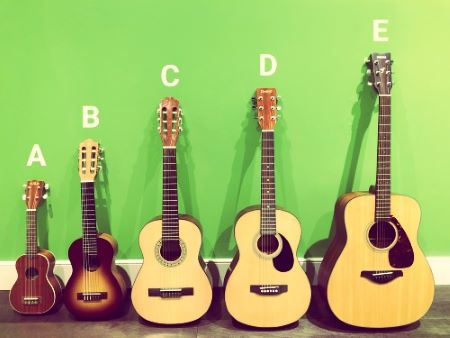
Use the table below to tell you the approximate age range for each type of guitar, along with length specifications. Although children can differ quite a bit in size, the guidelines in this table will definitely work for most.
| Child's Age | Recommended Guitar | Guitar Size |
|---|---|---|
| 2-5 | ukulele | ~ 21 in (54 cm) |
| 3-5 | guitalele | ~ 28 in (71 cm) |
| 5-8 | 1/2 size | ~ 34 in (86 cm) |
| 8-12 | 3/4 size | ~ 36 in (92 cm) |
| 12 + | full size | ~ 40 in (100 cm) |
Now, let's talk about each instrument in a bit more detail.
Ukulele
Age group: ~ 2 - 5

Although technically not a guitar, the ukulele can be a great starter instrument for little kids. Children as young as 2 can start plucking away at the strings and experiment with the different sounds they make. It is small, light-weight, and uses nylon strings, which are easy on the fingers.
An important distinctive feature of the ukulele is that it has 4 strings as opposed to the standard 6 of the guitalele or other guitars. This definitely makes it easier for kids to play, but those who plan to move on to a guitar will eventually have to make the transition to 6 strings.
There are 4 main types of ukuleles: soprano, concert, tenor and baritone. Each one is slightly bigger and has a slightly different sound. The one we discuss here (see photo above) is a soprano ukulele, which is by far the most popular type and is what is considered a "standard" ukulele.
In addition to being a neat starter instrument for kids, the ukulele is also an instrument in its own right. Plenty of adults play the ukulele instead of guitar and really enjoy its compact size and distinctive sound.
Thinking of buying a ukulele? Here are our recommendations based on our students' experience and feedback:
A basic, cheaper option:
- Soprano Ukulele (External Link)
A fancier, brand-name option:
- Kala KA-S Soprano Ukulele (External Link)
Guitalele
Age group: ~ 3 - 5
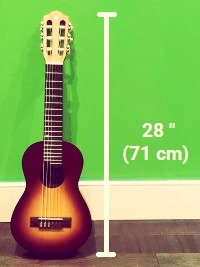
Another great option for little kids is the guitalele, which is ideal for 3 to 5 year-olds. The manufacturer Yamaha, who first introduced this instrument, describes it as "Half guitar, half ukulele…100% fun!"
As the name suggests, the guitalele is a sort of hybrid between the guitar and the ukulele. It is closer to the ukulele in the way it sounds and closer to a guitar in its more mature shape and its number of strings (6). Also like the ukulele, it uses nylon strings.
Although it resembles a guitar - it is actually tuned differently than a guitar - a 4th up. So, from bottom to top, the guitalele's strings are A-D-G-C-E-A as opposed to the guitar's E-A-D-G-B-E. This means that the chord shapes on a guitalele won't give you the same chords as on the guitar. Despite this, it will get your child accustomed to 6 strings.
Some people prefer the guitalele to the ukulele precisely because it has the standard 6 strings of a regular guitar, which makes a later transition to a guitar a bit easier.
Thinking of buying a guitalele? Here are our recommendations based on our students' experience and feedback:
A solid and reliable choice:
- Yamaha GL Series Guitalele (External Link)
1/2 (half-size) Guitar
Age group: ~ 5 - 8
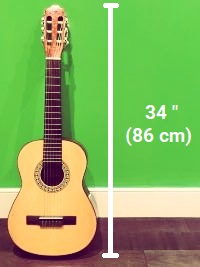
Half size guitars are aimed at 5 to 8 year-olds, which makes them quite popular since many children start taking guitar lessons at this age.
1/2 size guitars are tuned just like real guitars, so children get a genuine guitar experience with this instrument.
They come in classical (nylon strings) and acoustic (steel strings) versions, though the nylon-string versions are recommended and preferred by most for learning as they are easier on the fingers.
Some electric versions of the 1/2 guitar also exist on the market, though most teachers would not recommend an electric guitar at this stage (unless your child is absolutely set on one!).
Thinking of buying a 1/2 guitar? Here are our recommendations based on our students' experience and feedback:
A cheaper, beginner option (30"):
- CB Sky Acoustic Guitar (External Link)
A more expensive option (30"):
- BCP Kids Acoustic Guitar (External Link)
3/4 (three-quarter size) Guitar
Age group: ~ 8 - 12
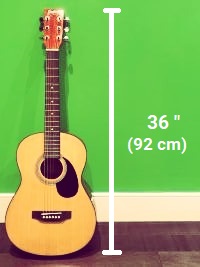
The 3/4 size guitar is another very popular guitar size for young children and is best suited for 8 to 12 year-olds. As with the 1/2 size guitar, it also comes in classical, acoustic, and electric versions.
The 3/4 guitar has standard guitar tuning (E-A-D-G-B-E) and, at 36" inches, is very close in size and feel to the full size guitar.
Although the classical (nylon strings) version is still the preferred choice for most, some students at this stage will already begin using acoustic versions (steel strings) to start preparing their fingers for the real, full size acoustic guitar.
Because of its slightly smaller size, some adults actually prefer to play the 3/4 size guitar as opposed to a full size one. In fact, the famous singer/songwriter Ed Sheeran is known to prefer 3/4 size guitars.
Thinking of buying a 3/4 size guitar? Here are our recommendations based on our students' experience and feedback:
Cheaper option:
- CNBLUE 3/4 Size Classical Guitar (External Link)
More expensive but solid option:
- Yamaha 3/4 Acoustic Guitar (External Link)
Full Size Guitar
Age group: ~ 12 +
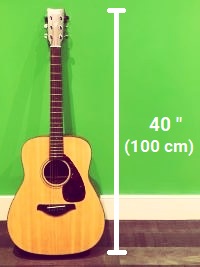
When we hear the word "guitar", we usually mean a full size guitar. This is the famous instrument that many of your favourite bands and artists use and the one we usually hear on the radio or on recordings.
There are numerous brands and varieties of acoustic, classical, and electric full size guitars to choose from, so you are sure to find something that appeals to your taste.
Except for classical versions, full size guitars mostly come with steel strings.
Thinking of buying a full size guitar? Here are our recommendations based on our students' experience and feedback:
For classical (nylon strings) full size guitars:
Cheaper option:
- J&Z Full Size Classical Guitar (External Link)
More pricey but reliable option:
- Yamaha Full Size Classical Guitar (External Link)
For acoustic (steel strings) full size guitar:
A very solid option:
- Yamaha F325D Acoustic Guitar (External Link)
For electric full size guitar:
Cheaper option:
- Fesley Electric Guitar (with accessories) (External Link)
A slightly more expensive, brand name option:
- Squier Electric Guitar by Fender (with an amp and accessories) (External Link)
Conclusion
Figuring out the right guitar size for your child can be daunting, and we hope that we were able to simply and demystify this process for you in this guide. We wish you and your family the best of luck and lots of interesting musical adventures ahead!
Just fill out our quick trial lesson form and wait to hear from us within 1-2 business days. If you like your trial lesson, you can sign up for regular lessons with us! Our lessons are available online (Zoom or Skype) as well as in-person if you live close to our location. Start learning your favorite instrument with one of our amazing teachers today!
